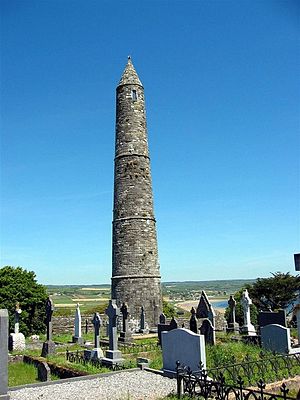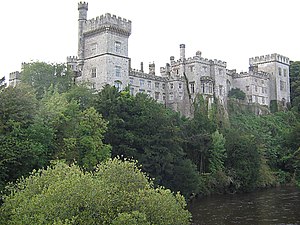
County Waterford (Contae Phort Láirge) is in Southeast Ireland, and historically part of Munster. It's mostly low-lying, but with mountains of 500-700 m along its border with County Tipperary to the north. Its main attractions are Waterford city (Ireland's oldest), the mansions and gardens dotted about the countryside, and the little harbours and beach resorts along its coast.
Cities and towns
edit- 1 Waterford (Port Láirge), the county town and only city, has a rich Viking, medieval and Georgian heritage.
- 2 Dunmore East (An Dún Mór Thoir) is a fishing port and seaside resort.
- 3 Tramore (Trá Mhór) has a long beach popular for surfing.
- 4 Dungarvan (Dún Garbhán) is a small coastal town with a Norman castle. South around the village of Helvick is the county's only Gaeltacht, where Irish is the primary language.
- 5 Ardmore (Aird Mhór) is a little beach resort with a well-preserved Round Tower and cathedral ruins.
- 6 Lismore (Lios Mór) has an elegant castle, gardens and cathedral, with other mansions and gardens in the nearby countryside.
Other destinations
edit- 1 Comeragh Mountains are a block of twelve peaks in the east of the county, with Fauscoum the highest at 792 m, and attractive glaciated scenery. Good access routes are the "Magic Road" above Mahon Bridge to the south, and the Nire Valley from the west.
- 2 Knockmealdown Mountains are the range dividing the west of the county from County Tipperary. Knockmealdown itself is the highest at 794 m. They're Devonian Old Red Sandstone, with deep gullies etched by post-glacial run-off. They're accessed from the minor roads above Lismore.
- 3 Shean Beg is the geographical oddity known as a "pene-enclave". It's a tract of farmland that is part of County Waterford, but connected only by a farm gate between diagonally-set fields and otherwise surrounded by County Cork. A public lane skims the south edge of it, but the boundary isn't signposted and there's nothing to see.
Understand
editThe tribal domains of southwest Ireland coalesced in the Iron Ages into the Kingdom of Munster. Especially in the low-lying terrain around Waterford, there were harbours and navigable rivers that brought outside influence - and not just from overseas. In an age when overland travel was quagmire-cum-nightmare, early missionaries such as St Declan and St Patrick came by sea, christianising the Déise - the local Celtic tribe - from the 5th century. The Vikings came to raid, but why grab a pig and rush back to sea when you could take permanent possession of this fertile land? So they settled all the way up the navigable River Suir, founding Veðrafjǫrðr - Waterford - in the 9th century. Their settlement 5 km further upriver may have been even more significant but there's nothing left there.
In medieval times the Normans increasingly controlled Ireland - and Waterford was easier to reach by sea from England than much of Great Britain. They divided the country into shires, which evolved into the present-day counties, though it would be another 700 years before the administrative focus shifted from weapon-takes and harsh justice to bin collections and library vans. Meanwhile a series of barons grew and became over-mighty, warring with each other and with London authority. The Desmond dynasty was troublesome into the reign of Queen Elizabeth, but was then beaten and their lands handed over to staunch Protestants. One beneficiary was soldier-of-fortune Sir Walter Raleigh, who became a major landowner around Lismore and Youghal. He in turn overstepped, to be deposed and executed once a Catholic monarch again ruled England. He sold off his estates to the Earl of Cork, whose son Robert Boyle the physicist and chemist was born at Lismore Castle.
Waterford grew into a large city with trade in Georgian and Victorian times, but was limited by its twisty narrow river channel - very difficult to navigate under sail, so Dunmore served as the port until steam-powered iron vessels were developed. The county remained agricultural, with little industry, though there was copper mining towards Dungarvan, and its glass-making (Waterford Crystal) lasted until 2009. That meant that agricultural slumps hit the area hard - the Great Famine of 1845-1849 being the worst of several. But for the wealthy few, it was an agreeable place for building grand mansion houses with the lucre they'd acquired elsewhere. Many of these stately homes and gardens can be visited: the IRA burned down as many as it could both before and after Irish independence, but some were re-built while others are picturesque ruins. Waterford also earned a special place in the history of travel in July 1985 when a 15-seater turboprop first juddered into its skies towards London Gatwick. It was a mere side-hustle for the aviation business of Tony Ryan (1936-2007), but it's now Ryanair.
Get in
edit
Dublin (DUB IATA) is usually the best airport to fly into, for its range of flights and good onward transport. You might also fly into Cork or Shannon and hire a car. Waterford Airport has no commercial flights.
Direct trains run from Dublin Heuston via Newbridge, Kildare, Athy, Carlow, Bagenalstown, Kilkenny and Thomastown to Waterford, taking 2 hr 15 min. There are seven M-Sa and four on Sunday.
Two trains run M-Sa from Limerick Junction (for Cork, Limerick and Dublin) via Tipperary, Cahir, Clonmel and Carrick-on-Suir to Waterford.
Expressway Bus 4 runs every hour or two from Dublin Airport, taking 3 hours to Waterford via Dublin Busáras and Heuston, Carlow and Thomastown.
Expressway Bus 55 runs daily every two hours from Limerick via Tipperary, Cahir, Clonmel and Carrick-on-Suir to Waterford.
Expressway Bus 40 runs hourly from Cork via Youghal and Dungarvan to Waterford, and continues to Wexford and Rosslare Harbour, for ferries to Wales and the Continent.
By road from Dublin, take M9 for Waterford and the east of the county. For Lismore, Ardmore and the west, you could take M8 to Cahir then the scenic road over the hills.
Get around
editYou need a car. Public transport is sparse even between the main towns, and non-existent in the countryside where many of the sights of interest are found.
See individual towns for Local Link bus services. They're generally too sparse for visitors, but a few are practical options, such as the Dungarvan-Ardmore bus.
See
edit- Waterford's medieval museum is a stand-out.
- Pleasant beach resorts are Dunmore East and Tramore. Ardmore beach is polluted, but the Round Tower and religious ruins are worth the trip.
- Stately mansions and gardens are dotted around the county, with a rich collection near Lismore. As well as its castle and gardens, the Ballyswaggartmore Towers illustrate what happens when you spend more on your gate lodge than a multi-millionaire would spend on the mansion itself, and Dromona Gate is what happens if you recreate Brighton Pavilion on an Irish country lane.
Do
edit
- What's on? Listen to WLR FM on 95.1 / 97.5 / 94.8 MHz or read Waterford News & Star or Munster Express.
- Hillwalking in the Comeragh and Knockmealdown Mountains. They're mostly in the 500-700 m range and not technically demanding, but often wet and muddy.
- Deise Greenway runs for 46 km along an old railway track bed between Waterford and Dungarvan. Near the city it passes Mount Congreve, and runs alongside the heritage WSV narrow-gauge railway. Further west are a series of impressive viaducts and a tunnel.
- The coastal resorts have boat charters for angling and sight-seeing. There's also river angling in season.
- Gaelic games: the County GAA plays hurling and Gaelic football in Waterford and occasionally in Dungarvan. There are almost 50 club teams across the county.
Eat
edit- A blaa is a floury bread bun unique to this region; it's a protected geographical name under EU law. They're similar to baps, but square, softer and more doughy. Soft blaas are slightly sweet and malty and dissolve in the mouth, crusty blaas are crunchy at first bite, then chewy within. A breakfast blaa might contain egg, bacon or sausage. They need to be eaten fresh-baked, they don't keep, which doesn't fit with modern mass production and delivery. Only three bakeries still produce blaas by the traditional method: Walsh's Bakehouse and Hickey's Bakery in Waterford, and Barron's Bakery in Cappoquin near Lismore. Kilmacow Bakery on the outskirts of Waterford but in County Kilkenny is no longer active in 2020; blaas used also to be made in Wexford. "Blaa" may derive from blanc and the legend goes that they were introduced by the Huguenots in the 17th century, however white flour was uncommon in that era.
- Waterford has the best selection of restaurants, including Japanese and upmarket French.
- Beyond the city, Tannery in Dungarvan is the stand-out.
- Mostly it's a choice of bar food or the local golf hotel.
Drink
edit
- All the towns have bars, or try the hotels.
- Ballinalira on N25 south from Dungarvan had a mass grave for victims of the Famine. And so many grave-diggers and body-carts were needed, they had to build a pub An Seanachai to serve them all. It's still serving.
- Metalman Brewing Co in Waterford produces an off-beat selection of beers; no tours.
- Dungarvan has a brewery producing Black Rock Stout and other ales, which you can tour.
- There's a distillery in Waterford and another near Lismore, with tours available.
Stay safe
editStandard advice about road safety, protecting valuables, and dressing for the weather. On the water, never underestimate the power of the Atlantic.
Go next
edit- County Cork where Cork itself is a lively place.
- County Kilkenny has prehistoric ruins, old castles, and fields as green as any in Ireland.
- County Limerick has a remarkable range, from prehistoric Lough Gur to medieval castles and the cosmopolitan city of Limerick.
- County Tipperary highlights are Cahir with its river island castle, Cashel religious complex, and the Vale of Aherlow.
- County Wexford has a sweeping coastline and historic small towns.

